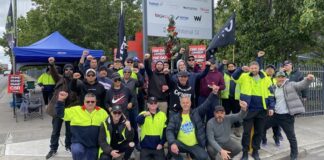Hawke and Keating’s Accord agreement was designed to hold back wages and conditions and weakened union power, argues Feiyi Zhang
IN THE 2007 elections, mass opposition to Howard’s neo-liberal agenda led to a landslide victory for Kevin Rudd and the Australian Labor Party.
Rudd promised to rip up Howard’s Workchoices legislation, the pinnacle of Howard’s attacks on rights at work and union organising. But Rudd didn’t rip up WorkChoices, it became FairWork Australia, or WorkChoices Lite.
But it is less well known that the neo-liberal policies that laid the basis for Workchoices actually began in the period of Labor rule between 1983 and 1996, during the Hawke and Keating governments. Looking at this period of history reveals the limitations of Labor in government today.
The origins of the Accord
The Australian economy was plagued by economic crisis from the mid 1970s to the mid 1980s. The failure to solve the crisis was central to the end of both the Whitlam Labor government in 1975 and the Fraser Coalition government in 1983. Whitlam attacked working conditions, cut jobs and rolled back social services, but was sacked by the Governor General and later replaced by the Fraser Coalition government, ushered in on a promise to solve the economic crisis and rein in the unions.
But working class resistance continued throughout the period of Fraser in power. A wave of strikes from 1979-81 involved more than four million workers in nearly 7400 disputes, accounting for more than 11 million strike days. Like the strike wave in the early 1970s, it won wage increases and raised union membership. This occurred alongside important political movements such as opposition to the stripping back of Medicare and resistance to new uranium mines.
The Accord was the ruling class’ solution to this problem of working class militancy. The Accord was a tripartite agreement between Australia’s peak trade union body, the Australian Council of Trade Unions (ACTU), business and the Labor government under Prime Minister Bob Hawke.
Hawke pitched the Accord as an agreement that would enable an increase in the “social wage”—the redistribution of taxes and things like maintaining Medicare. In exchange unions agreed to wage restraint.
This meant no wage claims outside six monthly indexes set by the Arbitration commission, effectively a no-strike agreement. The union leaders portrayed this as a “less confrontational and more rational approach” with the Labor Government.
Such was the level of support among union leaders at the time that NSW Nurses Association was the only union that voted against the agreement.
The “consensus” relationship of the Accord is still commonly claimed to have been beneficial for all involved by many senior trade union figures. Even those critical of the Accord think that the problem was the way in which the Accord was managed. Some claim it was responsible for holding at bay the sharp attack on workplace rights and conditions that came with Howard. Even when union officials saw the impact of the Accord in degrading former structures of union power or causing a decline in wages, there was still overwhelmingly no real challenge to the Accord itself.
Neo-liberalism: making the working class pay
But a closer examination of the Accord shows it was used by the Labor government to manage the problems of capitalism and to make the working class pay for both the economic crisis and recovery. It went along with the neoliberal restructuring of Australian capitalism that ushered in a period of deregulation, privatisation and economic rationalism.
Through seven phases of the Accord from 1983 to 1996, successive Labor governments in alliance with business, attacked working conditions and job organisation. The Accord paved the way for Howard’s attacks on work rights with the Workplace Relations Act 1996 and the introduction of Australian Workplace Agreements (AWAs).
The appeal to business and government lay in the Accord’s ability to restrain wages. Wage restraint is a key mechanism used to restore profits—decreasing the cost of wages increases total profit. The initial Accord program included a commitment by unions not to pursue wage rises. The Accord was also designed to improve profit rates by increasing the intensity of work. This meant attacking any union or sections of workers that challenged the Accord.
The Accord meant that that wage determinations went from a centralised arbitration system to what was called “managed decentralism”. Centralised arbitration had tied wages to the cost of living. But a decentralised system meant tying wage increases to increased productivity, and later into enterprise bargaining. Enterprise bargaining drove greater labour flexibility (read: an attack on standard hours and conditions) by tying wages to the productivity of individual businesses. In 1993, under PM Paul Keating, Labor’s Reform Act installed enterprise bargaining as the primary mechanism of wage determination.
This was a drastic restructure that boosted profits by increasing the exploitation of workers.
Phase 3 of the Accord, in 1987, focused on the “elimination of restrictive work practices”—which meant wage increases only in exchange for trade-offs.
From 1981-92 wage growth averaged only 0.25 per cent per annum. Since the introduction of enterprise bargaining in the early 1990s, real wages have stagnated. The boost for business over the last 25 years has been dramatic. The profit share of total income in Australia reached record levels in 2007-8, while the wages share hit record lows.
Labor in power
To understand how Labor was able to implement the Accord, it is essential to understand its relationship with the trade unions (in particular the trade union leadership) and the working class in Australia.
The Accord agreement was characteristic of the social democratic nature of the Labor Party.
The ALP originated from working class struggles demanding economic and social reforms through government. In contrast to the conservative parties, the ALP has a distinct connection with the trade unions and the working class. The trade unions still control 50 per vent of the national Labor conference. Trade union officials often become members of Parliament and senior leaders of the Labor Party.
Bob Hawke, for example, was a secretary of the ACTU, the peak trade union body, before becoming a Labor Prime Minister. Greg Combet was secretary of the ACTU and ran the unions’ Your Rights at Work campaign, before getting a safe Labor seat. Moreover, there is still a significant (but declining) working class membership of the Labor Party and it is still the party that the more class-conscious workers look to to represent their interests. The material and ideological link between the Labor Party, trade unions and the working class was essential to Labor’s ability to implement the Accord.
A Labor government in power is fundamentally committed to managing the capitalist system and therefore to resolving class contradictions in favour of business. In the years prior to the Accord neither Whitlam nor Fraser had been able to successfully rein in the unions sufficiently to make the working class pay for declining profitability.
When the recession hit in 1974, union militancy produced the highest number of workings days lost due to industrial action in Australian history. This underpinned the efforts of big business to drive the Whitlam government out of office. In 1975, the Fraser Coalition government took office in particular to take on the unions. Yet a short commodities boom from 1979-81 gave unions and workers the confidence to push for another strike wave and win an increase in real wages.
In 1982 the boom in commodity prices collapsed, part of the sharpest downturn in the world economy since the Great Depression. There were mass sackings and a sharp decline in business investment. Rising unemployment gutted the unions and sapped the confidence of rank and file workers to fight.
A former centre of union strength was the Amalgamated Metal Workers Union (now Australian Manufacturing Worker Union, AMWU), whose “hot shops” set the benchmark for national wage increases.
But the recession meant the left unions, previously willing to use their industrial muscle in the good times to get a share of the profits, were now looking for an alternative political (read: parliamentary) strategy.
It was the combination of this recession and the election of a new Labor Government under Bob Hawke in 1983 that made the Accord possible.
The Accord seemed to offer union leaders an alternative to industrial action, something they were never entirely comfortable with. Union leaders accepted the no strike agreements, and policed them when workers rebelled, in return for wage increases determined by the Arbitration Commission. Wage agreements previously won through workplace militancy were now the subject of bureaucratic machinations with top officials and government institutions. Union activity was demobilised and organisation on the job declined as a result.
When the Accord was challenged, the Labor government used the state to attack workers. But it was the willingness of the union leaderships to isolate the rebel unions that allowed the Hawke Labor government to break the Builders Labourers’ Federation (BLF), and later the pilots, when they tried to break out of the Accord straightjacket.
Throughout the 1970s and early 1980s, the BLF had led important struggles that won victories for all building industry workers, including holiday pay, sick leave and dozens of other entitlements. Despite signing the Accord, the BLF continued to fight for wage rises and improvements in conditions, effectively breaching the Accord agreement. In 1986, the ALP, with the support of the bosses, deregistered the BLF. Police were called onto worksites to break picket lines and arrest BLF members. Collaborating union officials refused to allow workers with BLF tickets onto work sites.
In 1989, the Australian Federation of Airline Pilots lodged a 29 per cent pay claim on behalf of pilots at Australian Airlines (later Qantas) whose wages had significantly fallen behind inflation. A successful campaign would have boosted the confidence of other workers suffering under the Accord. But the ALP, again with the support of the ACTU, cancelled pilots’ awards, deregistered the union and threatened dismissals.
Hawke even used RAAF planes and pilots to break the dispute, brought in overseas pilots as scab labour and bailed out airlines with tens of millions of dollars. Only a small number of pilots were re-employed in Australia, and only then on individual contracts. The examples of the BLF and the pilots demonstrate the real agenda behind the Accord “consensus”.
Labor today
The introduction of enterprise bargaining under the Accord led to a shift away from the idea that wages should be tied to the cost of living. It also formally introduced the idea of “protected industrial action”, restricted to a defined bargaining period. It paved the way for Howard’s hugely unpopular Workplace Relations Act and then the WorkChoices legislation, which placed further restrictions on collective bargaining and enshrined individual contracts.
The experience of the Accord and enterprise bargaining has led some union officials to realise that they cannot rely on good relations with a Labor government to deliver gains for the working class. But in practice, their unwillingness to lead industrial action to win back the conditions taken off them led them straight back to relying on getting Labor elected as a strategy to defeat WorkChoices.
Nearing the 2007 election, the Your Rights at Work campaign officials changed the slogan from “Your rights at work, worth fighting for”, to “Your rights at work, worth voting for”.
The Accord demonstrated that although voting Labor still reflects an important union and working class vote, Labor in power is more concerned with the rights of business than the rights of workers. A Labor government will ruthlessly subordinate working class interests to the needs of the system if they think it is necessary.
Rudd and Gillard’s FairWork Australia is essentially WorkChoices Lite. It maintains key aspects of WorkChoices, including outlawing pattern bargaining (campaigning for wage rises across more than one workplace, e.g. industry wide) and limiting the right to strike to bargaining periods. They have kept the Australian Building and Construction Commission (ABCC), that fines building unions for organising on the job, in place.
But the union officials wound down the Your Rights At Work campaign. There have been occasional protests, and even illegal one day strikes, against the ABCC’s prosecution of construction workers—but no sustained campaign, mobilising the rank and file, to force Labor to scrap all of WorkChoices. The ACTU promised to make no demands of Gillard going into the 2010 election.
The defeat of the BLs and pilots by Hawke was never inevitable. If officials of other unions had been prepared to lead militant industrial solidarity action, there would have been a serious challenge to the Accord.
Similarly, if unions had used the industrial power of workers to really fight for our rights at work after Rudd’s election, we would not have WorkChoices Lite, unions would not be facing record fines and Ark Tribe would not be facing jail at the hands of the ABCC. The CFMEU has promised a national strike if Ark is jailed. But far more is now at stake.
The threat of an Abbott minority government is a threat to the union movement as a whole. A mass mobilisation against Abbott would be the best action the unions could take to send a message to Labor and to ensure we don’t see a return of the Coalition.
We cannot rely on Labor governments, but only on workers’ industrial power. If the unions had fought Rudd and Gillard, we would not have a hung Parliament.
Regardless of whether Abbott or Gillard forms government, there is an urgent need to rebuild rank-and-file organisation and the political networks in the unions that can lay the basis for a renewed militancy. Until unions are willing to use their industrial power for political and economic ends, ordinary people will keep paying for crises of the system.





